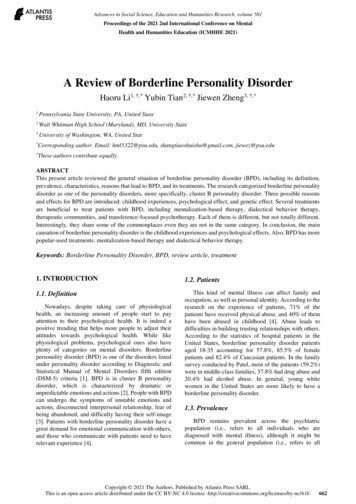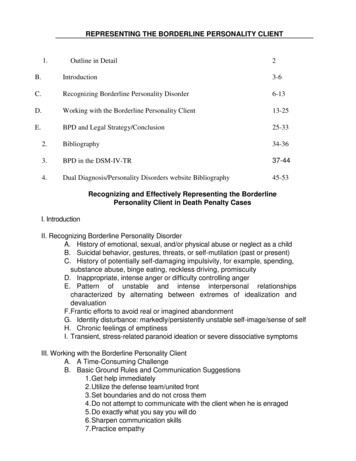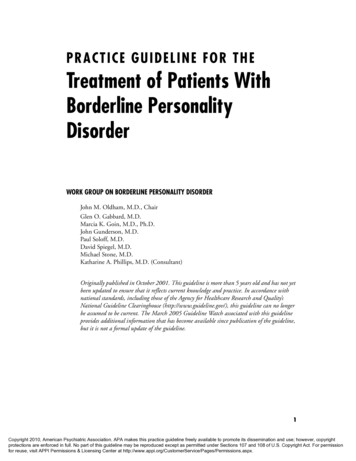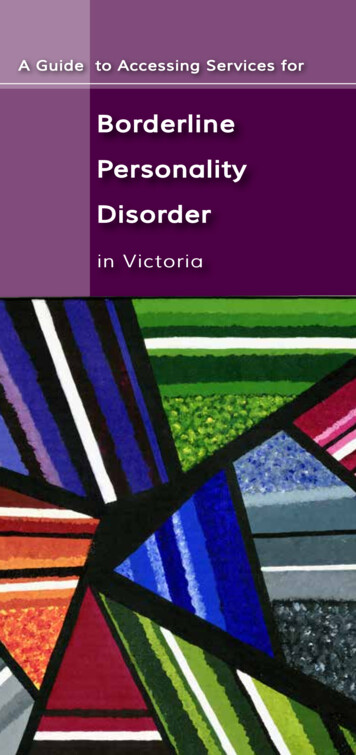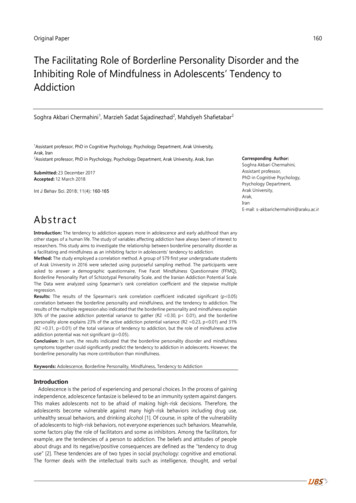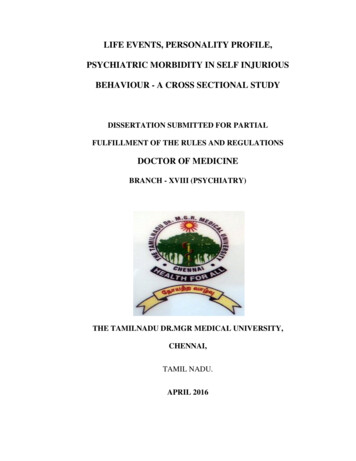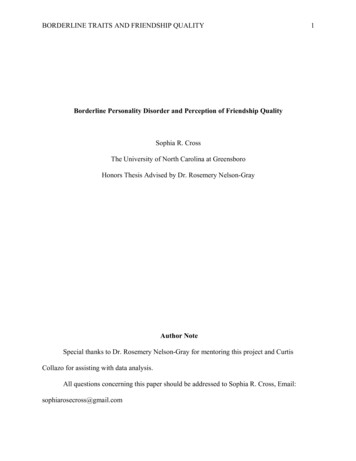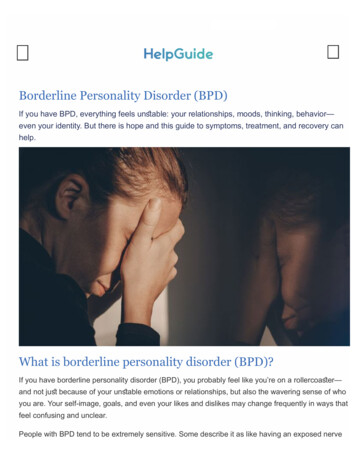
Transcription
Borderline Personality Disorder (BPD)If you have BPD, everything feels unsable: your relationships, moods, thinking, behavior—even your identity. But there is hope and this guide to symptoms, treatment, and recovery canhelp.What is borderline personality disorder (BPD)?If you have borderline personality disorder (BPD), you probably feel like you’re on a rollercoaser—and not jus because of your unsable emotions or relationships, but also the wavering sense of whoyou are. Your self-image, goals, and even your likes and dislikes may change frequently in ways thatfeel confusing and unclear.People with BPD tend to be extremely sensitive. Some describe it as like having an exposed nerve
ending. Small things can trigger intense reactions. And once upset, you have trouble calming down.It’s easy to undersand how this emotional volatility and inability to self-soothe leads to relationshipturmoil and impulsive—even reckless—behavior.When you’re in the throes of overwhelming emotions, you’re unable to think sraight or saygrounded. You may say hurtful things or act out in dangerous or inappropriate ways that make youfeel guilty or ashamed afterwards. It’s a painful cycle that can feel impossible to escape. But it’s not.There are efective BPD treatments and coping skills that can help you feel better and back in controlof your thoughts, feelings, and actions.BPD is treatableIn the pas, many mental health professionals found it difcult to treat borderline personality disorder(BPD), so they came to the conclusion that there was little to be done. But we now know that BPD istreatable. In fact, the long-term prognosis for BPD is better than those for depression and bipolardisorder. However, it requires a specialized approach. The bottom line is that mos people with BPDcan and do get better—and they do so fairly rapidly with the right treatments and support.Healing is a matter of breaking the dysfunctional patterns of thinking, feeling, and behaving that arecausing you disress. It’s not easy to change lifelong habits. Choosing to pause, refect, and then actin new ways will feel unnatural and uncomfortable at frs. But with time you’ll form new habits thathelp you maintain your emotional balance and say in control.Recognizing borderline personality disorderDo you identify with the following satements? I often feel “empty.”My emotions shift very quickly, and I often experience extreme sadness, anger, andanxiety.I’m constantly afraid that the people I care about will abandon me or leave me.I would describe most of my romantic relationships as intense, but unstable.The way I feel about the people in my life can dramatically change from one moment tothe next—and I don’t always understand why.I often do things that I know are dangerous or unhealthy, such as driving recklessly,
having unsafe sex, binge drinking, using drugs, or going on spending sprees. I’ve attempted to hurt myself, engaged in self-harm behaviors such as cutting, or When I’m feeling insecure in a relationship, I tend to lash out or make impulsivethreatened suicide.gestures to keep the other person close.If you identify with several of the satements, you may sufer from borderline personality disorder. Ofcourse, you need a mental health professional to make an ofcial diagnosis, as BPD can be easilyconfused with other issues. But even without a diagnosis, you may fnd the self-help tips in thisarticle helpful for calming your inner emotional sorm and learning to control self-damaging impulses.Signs and symptomsBorderline personality disorder (BPD) manifess in many diferent ways, but for the purposes ofdiagnosis, mental health professionals group the symptoms into nine major categories. In order to bediagnosed with BPD, you mus show signs of at leas fve of these symptoms. Furthermore, thesymptoms mus be long-sanding (usually beginning in adolescence) and impact many areas of yourlife.The 9 symptoms of BPD1. Fear of abandonment. People with BPD are often terrified of being abandoned or left alone.Even something as innocuous as a loved one arriving home late from work or going away forthe weekend may trigger intense fear. This can prompt frantic efforts to keep the other personclose. You may beg, cling, start fights, track your loved one’s movements, or even physicallyblock the person from leaving. Unfortunately, this behavior tends to have the opposite effect—driving others away.2. Unstable relationships. People with BPD tend to have relationships that are intense andshort-lived. You may fall in love quickly, believing that each new person is the one who willmake you feel whole, only to be quickly disappointed. Your relationships either seem perfect orhorrible, without any middle ground. Your lovers, friends, or family members may feel like theyhave emotional whiplash as a result of your rapid swings from idealization to devaluation,anger, and hate.
3. Unclear or shifting self-image. When you have BPD, your sense of self is typically unstable.Sometimes you may feel good about yourself, but other times you hate yourself, or even viewyourself as evil. You probably don’t have a clear idea of who you are or what you want in life.As a result, you may frequently change jobs, friends, lovers, religion, values, goals, or evensexual identity.4. Impulsive, self-destructive behaviors. If you have BPD, you may engage in harmful,sensation-seeking behaviors, especially when you’re upset. You may impulsively spend moneyyou can’t afford, binge eat, drive recklessly, shoplift, engage in risky sex, or overdo it withdrugs or alcohol. These risky behaviors may help you feel better in the moment, but they hurtyou and those around you over the long-term.5. Self-harm. Suicidal behavior and deliberate self-harm is common in people with BPD. Suicidalbehavior includes thinking about suicide, making suicidal gestures or threats, or actuallycarrying out a suicide attempt. Self-harm encompasses all other attempts to hurt yourselfwithout suicidal intent. Common forms of self-harm include cutting and burning.6. Extreme emotional swings. Unstable emotions and moods are common with BPD. Onemoment, you may feel happy, and the next, despondent. Little things that other people brushoff can send you into an emotional tailspin. These mood swings are intense, but they tend topass fairly quickly (unlike the emotional swings of depression or bipolar disorder), usuallylasting just a few minutes or hours.7. Chronic feelings of emptiness. People with BPD often talk about feeling empty, as if there’sa hole or a void inside them. At the extreme, you may feel as if you’re “nothing” or “nobody.”This feeling is uncomfortable, so you may try to fill the void with things like drugs, food, or sex.But nothing feels truly satisfying.8. Explosive anger. If you have BPD, you may struggle with intense anger and a short temper.You may also have trouble controlling yourself once the fuse is lit—yelling, throwing things, orbecoming completely consumed by rage. It’s important to note that this anger isn’t alwaysdirected outwards. You may spend a lot of time feeling angry at yourself.9. Feeling suspicious or out of touch with reality. People with BPD often struggle withparanoia or suspicious thoughts about others’ motives. When under stress, you may even losetouch with reality—an experience known as dissociation. You may feel foggy, spaced out, or asif you’re outside your own body.Common co-occurring disordersBorderline personality disorder is rarely diagnosed on its own. Common co-occurring disorders
include: depression or bipolar disordersubstance abuseeating disordersanxiety disordersWhen BPD is successfully treated, the other disorders often get improve, too. But the reverse isn’talways true. For example, you may successfully treat symptoms of depression and sill sruggle withBPD.Causes—and hopeMos mental health professionals believe that borderline personality disorder (BPD) is caused by acombination of inherited or internal biological factors and external environmental factors, such astraumatic experiences in childhood.Brain diferencesThere are many complex things happening in the BPD brain, and researchers are sill untanglingwhat it all means. But in essence, if you have BPD, your brain is on high alert. Things feel morescary and sressful to you than they do to other people. Your fght-or-fight switch is easily tripped,and once it’s on, it hijacks your rational brain, triggering primitive survival insincts that aren’t alwaysappropriate to the situation at hand.This may make it sound as if there’s nothing you can do. After all, what can you do if your brain isdiferent? But the truth is that you can change your brain. Every time you practice a new copingresponse or self-soothing technique you are creating new neural pathways. Some treatments, suchas mindfulness meditation, can even grow your brain matter. And the more you practice, the srongerand more automatic these pathways will become. So don’t give up! With time and dedication, youcan change the way you think, feel, and act.Personality disorders and sigmaWhen psychologiss talk about “personality,” they’re referring to the patterns of thinking, feeling, andbehaving that make each of us unique. No one acts exactly the same all the time, but we do tend tointeract and engage with the world in fairly consisent ways. This is why people are often described
as “shy,” “outgoing,” “meticulous,” “fun-loving,” and so on. These are elements of personality.Because personality is so intrinsically connected to identity, the term “personality disorder” mightleave you feeling like there’s something fundamentally wrong with who you are. But a personalitydisorder is not a character judgment. In clinical terms, “personality disorder” means that your patternof relating to the world is signifcantly diferent from the norm. (In other words, you don’t act in waysthat mos people expect). This causes consisent problems for you in many areas of your life, suchas your relationships, career, and your feelings about yourself and others. But mos importantly,these patterns can be changed!Self-help tips: 3 keys to coping with BPD1. Calm the emotional storm2. Learn to control impulsivity and tolerate distress3. Improve your interpersonal skillsSelf-help tip 1: Calm the emotional stormAs someone with BPD, you’ve probably spent a lot of time fghting your impulses and emotions, soacceptance can be a tough thing to wrap your mind around. But accepting your emotions doesn’tmean approving of them or resigning yourself to sufering. All it means is that you sop trying to fght,avoid, suppress, or deny what you’re feeling. Giving yourself permission to have these feelings cantake away a lot of their power.Try to simply experience your feelings without judgment or criticism. Let go of the pas and the futureand focus exclusively on the present moment. Mindfulness techniques can be very efective in thisregard. Start by observing your emotions, as if from the outside.Watch as they come and go (it may help to think of them as waves).Focus on the physical sensations that accompany your emotions.Tell yourself that you accept what you’re feeling right now.Remind yourself that just because you’re feeling something doesn’t mean it’s reality.
Lisen to HelpGuide’s Eye of the Storm meditationDo something that simulates one or more of your sensesEngaging your sense is one of the quickes and easies ways to quickly self-soothe. You will need toexperiment to fnd out which sensory-based simulation works bes for you. You’ll also need diferentsrategies for diferent moods. What may help when you’re angry or agitated is very diferent fromwhat may help when you’re numb or depressed. Here are some ideas to get sarted:Touch. If you’re not feeling enough, try running cold or hot (but not scalding hot) water over yourhands; hold a piece of ice; or grip an object or the edge of a piece of furniture as tightly as you can. Ifyou’re feeling too much, and need to calm down, try taking a hot bath or shower; snuggling under thebed covers, or cuddling with a pet.Tase. If you’re feeling empty and numb, try sucking on srong-favored mints or candies, or slowlyeat something with an intense favor, such as salt-and-vinegar chips. If you want to calm down, trysomething soothing such as hot tea or soup.Smell. Light a candle, smell the fowers, try aromatherapy, spritz your favorite perfume, or whip upsomething in the kitchen that smells good. You may fnd that you respond bes to srong smells, suchas citrus, spices, and incense.Sight. Focus on an image that captures your attention. This can be something in your immediateenvironment (a great view, a beautiful fower arrangement, a favorite painting or photo) or somethingin your imagination that you visualize.Sound. Try lisening to loud music, ringing a buzzer, or blowing a whisle when you need a jolt. Tocalm down, turn on soothing music or lisen to the soothing sounds of nature, such as wind, birds, orthe ocean. A sound machine works well if you can’t hear the real thing.Reduce your emotional vulnerabilityYou’re more likely to experience negative emotions when you’re run down and under sress. That’swhy it’s very important to take care of your physical and mental well-being.Take care of yourself by:
Avoid mood-altering drugsEating a balanced, nutritious dietGetting plenty of quality sleepExercising regularlyMinimizing stressPracticing relaxation techniquesTip 2: Learn to control impulsivity and tolerate distressThe calming techniques discussed above can help you relax when you’re sarting to becomederailed by sress. But what do you do when you’re feeling overwhelmed by difcult feelings? This iswhere the impulsivity of borderline personality disorder (BPD) comes in. In the heat of the moment,you’re so desperate for relief that you’ll do anything, including things you know you shouldn’t—suchas cutting, reckless sex, dangerous driving, and binge drinking. It may even feel like you don’t have achoice.Moving from being out of control of your behavior to being in controlIt’s important to recognize that these impulsive behaviors serve a purpose. They’re copingmechanisms for dealing with disress. They make you feel better, even if jus for a brief moment. Butthe long-term coss are extremely high.Regaining control of your behavior sarts with learning to tolerate disress. It’s the key to changingthe desructive patterns of BPD. The ability to tolerate disress will help you press pause when youhave the urge to act out. Insead of reacting to difcult emotions with self-desructive behaviors, youwill learn to ride them out while remaining in control of the experience.For a sep-by-sep, self-guided program that will teach you how to ride the “wild horse” ofoverwhelming feelings, check out our free Emotional Intelligence Toolkit . The toolkit teaches youhow to: get in touch with your emotionslive with emotional intensitymanage unpleasant or threatening 0/2020 6:39:50 PM]
Borderline Personality Disorder (BPD) - HelpGuide.org stay calm and focused even in upsetting situationsThe toolkit will teach you how to tolerate disress, but it doesn’t sop there. It will also teach you howto move from being emotionally shut down to experiencing your emotions fully. This allows you toexperience the full range of positive emotions such as joy, peace, and fulfllment that are also cut ofwhen you attempt to avoid negative feelings.A grounding exercise to help you pause and regain controlOnce the fght-or-fight response is triggered, there is no way to “think yourself” calm. Inseadof focusing on your thoughts, focus on what you’re feeling in your body. The followinggrounding exercise is a simple, quick way to put the brakes on impulsivity, calm down, andregain control. It can make a big diference in jus a few short minutes.Find a quiet spot and sit in a comfortable position.Focus on what you’re experiencing in your body. Feel the surface you’re sitting on. Feelyour feet on the foor. Feel your hands in your lap.Concentrate on your breathing, taking slow, deep breaths. Breathe in slowly. Pause for acount of three. Then slowly breathe out, once more pausing for a count of three. Continue todo this for several minutes.In case of emergency, disract yourselfIf your attempts to calm down aren’t working and you’re sarting to feel overwhelmed by desructiveurges, disracting yourself may help. All you need is something to capture your focus long enough forthe negative impulse to go away. Anything that draws your attention can work, but disraction is mosefective when the activity is also soothing. In addition to the sensory-based srategies mentionedpreviously, here are some things you might try:Watch TV. Choose something that’s the opposite of what you’re feeling: a comedy, if you’re feelingsad, or something relaxing if you’re angry or agitated.Do something you enjoy that keeps you busy. This could be anything: gardening, painting,
playing an insrument, knitting, reading a book, playing a computer game, or doing a Sudoku or wordpuzzle.Throw yourself into work. You can also disract yourself with chores and errands: cleaning yourhouse, doing yard work, going grocery shopping, grooming your pet, or doing the laundry.Get active. Vigorous exercise is a healthy way to get your adrenaline pumping and let of seam. Ifyou’re feeling sressed, you may want to try more relaxing activities such as yoga or a walk aroundyour neighborhood.Call a friend. Talking to someone you trus can be a quick and highly efective way to disractyourself, feel better, and gain some perspective.Tip 3: Improve your interpersonal skillsIf you have borderline personality disorder, you’ve probably sruggled with maintaining sable,satisfying relationships with lovers, co-workers, and friends. This is because you have troublesepping back and seeing things from other people’s perspective. You tend to misread the thoughtsand feelings of others, misundersand how others see you, and overlook how they’re afected by yourbehavior. It’s not that you don’t care, but when it comes to other people, you have a big blind spot.Recognizing your interpersonal blind spot is the frs sep. When you sop blaming others, you cansart taking seps to improve your relationships and your social skills.Check your assumptionsWhen you’re derailed by sress and negativity, as people with BPD often are, it’s easy to misread theintentions of others. If you’re aware of this tendency, check your assumptions. Remember, you’re nota mind reader! Insead of jumping to (usually negative) conclusions, consider alternative motivations.As an example, let’s say that your partner was abrupt with you on the phone and now you’re feelinginsecure and afraid they’ve los interes in you. Before you act on those feelings:Stop to consider the diferent possibilities. Maybe your partner is under pressure at work. Maybehe’s having a sressful day. Maybe he hasn’t had his cofee yet. There are many alternativeexplanations for his behavior.Ask the person to clarify their intentions. One of the simples ways to check your assumptions isto ask the other person what they’re thinking or feeling. Double check what they meant by theirwords or actions. Insead of asking in an accusatory manner, try a softer approach: “I could bewrong, but it feels like ” or “Maybe I’m being overly sensitive, but I get the sense that “
Put a sop to projectionDo you have a tendency to take your negative feelings and project them on to other people? Do youlash out at others when you’re feeling bad about yourself? Does feedback or consructive criticismfeel like a personal attack? If so, you may have a problem with projection.To fght projection, you’ll need to learn to apply the brakes—jus like you did to curb your impulsivebehaviors. Tune in to your emotions and the physical sensations in your body. Take note of signs ofsress, such as rapid heart rate, muscle tension, sweating, nausea, or light-headedness. Whenyou’re feeling this way, you’re likely to go on the attack and say something you’ll regret later. Pauseand take a few slow deep breaths. Then ask yourself the following three quesions:1. Am I upset with myself?2. Am I feeling ashamed or afraid?3. Am I worried about being abandoned?If the answer is yes, take a conversation break. Tell the other person that you’re feeling emotionaland would like some time to think before discussing things further.Take responsibility for your roleFinally, it’s important to take responsibility for the role you play in your relationships. Ask yourselfhow your actions might contribute to problems. How do your words and behaviors make your lovedones feel? Are you falling into the trap of seeing the other person as either all good or all bad? Asyou make an efort to put yourself in other people’s shoes, give them the beneft of the doubt, andreduce your defensiveness, you’ll sart to notice a diference in the quality of your relationships.Diagnosis and treatmentIt’s important to remember that you can’t diagnose borderline personality disorder on your own. So ifyou think that you or a loved one may be sufering from BPD, it’s bes to seek professional help. BPDis often confused or overlaps with other conditions, so you need a mental health professional toevaluate you and make an accurate diagnosis. Try to fnd someone with experience diagnosing andtreating BPD.The importance of fnding the right therapisThe support and guidance of a qualifed therapis can make a huge diference in BPD treatment andrecovery. Therapy may serve as a safe space where you can sart working through your relationship
Borderline Personality Disorder (BPD) - HelpGuide.organd trus issues and “try on” new coping techniques.An experienced professional will be familiar with BPD therapies such as dialectical behaviortherapy (DBT) and schema-focused therapy. But while these therapies have proven to be helpful,it’s not always necessary to follow a specifc treatment approach. Many experts believe that weeklytherapy involving education about the disorder, family support, and social and emotional skillstraining can treat mos BPD cases.It’s important to take the time to fnd a therapis you feel safe with—someone who seems to get youand makes you feel accepted and undersood. Take your time fnding the right person. But once youdo, make a commitment to therapy. You may sart out thinking that your therapis is going to be yoursavior, only to become disillusioned and feel like they have nothing to ofer. Remember that theseswings from idealization to demonization are a symptom of BPD. Try to sick it out with your therapisand allow the relationship to grow. And keep in mind that change, by its very nature, isuncomfortable. If you don’t ever feel uncomfortable in therapy, you’re probably not progressing.Don’t count on a medication cureAlthough many people with BPD take medication, the fact is that there is very little research showingthat it is helpful. What’s more, in the U.S., the Food and Drug Adminisration (FDA) has not approvedany medications for the treatment of BPD. This doesn’t mean that medication is never helpful—especially if you sufer from co-occurring problems such as depression or anxiety—but it is not acure for BPD itself.When it comes to BPD, therapy is much more efective. You jus have to give it time. However, yourdoctor may consider medication if: You have been diagnosed with both BPD and depression or bipolar disorder.You suffer from panic attacks or severe anxiety.You begin hallucinating or having bizarre, paranoid thoughts.You are feeling suicidal or at risk of hurting yourself or others.Get more helpAuthors: Melinda Smith, M.A. and Jeanne Segal, Ph.D. Las updated: September 2020.
These are elements of personality. Because personality is so intrinsically connected to identity, the term "personality disorder" might leave you feeling like there's something fundamentally wrong with who you are. But a personality disorder is not a character judgment. In clinical terms, "personality disorder" means that your pattern

